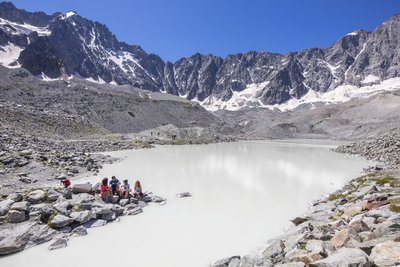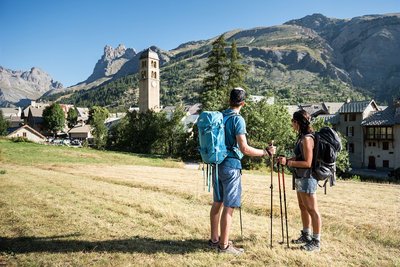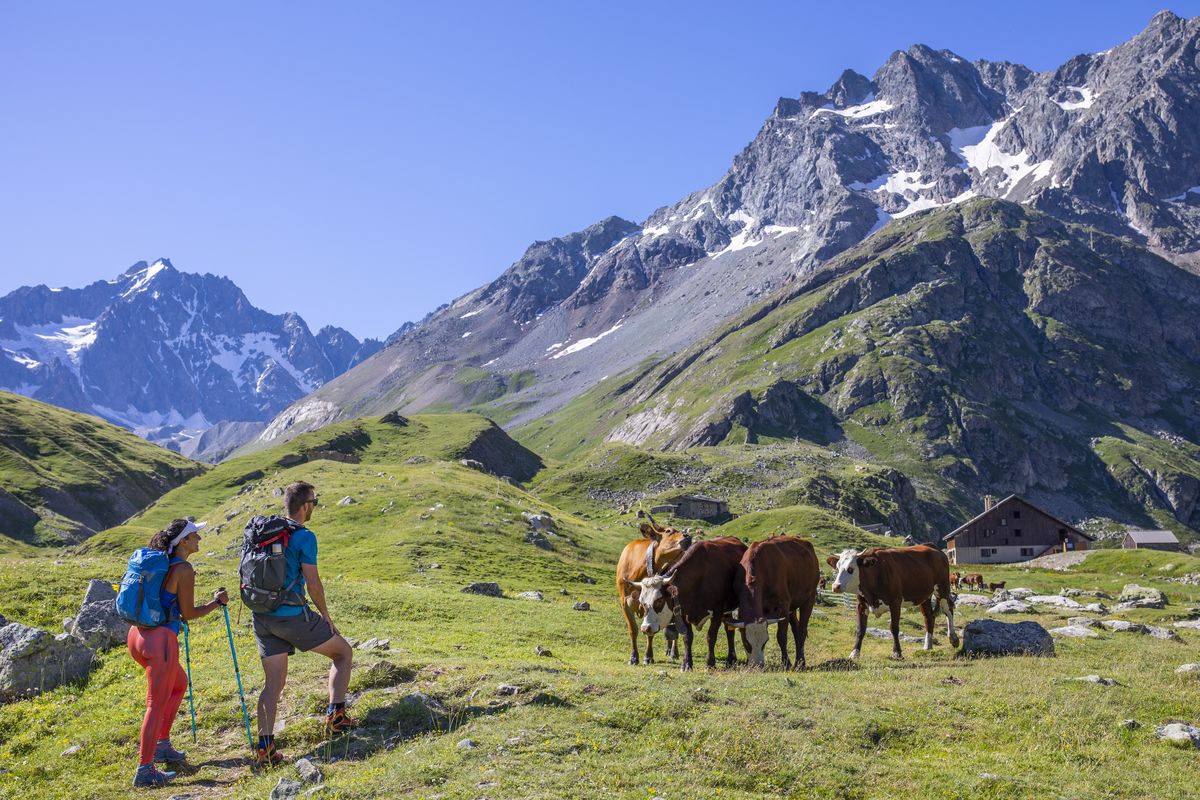
Tour of the Combeynot Peaks in three days
3 steps
Description
The Tour starts at the Col du Lauteret and quickly joins the Sentier des Crevasses taking hikers along the mountain side above the Romanche valley until they reach the L'Alpe de Villar refuges. The route then enters a small valley, following the Romanche up to its source.
For the second stage, make your way uphill from the Plan de l'Alpe refuges and cross several water courses before you reach the Col d'Arsine, where it is possible to get to the lakes formed by the glaciers of the same name. At this point, the backdrop is a high mountain landscape. The trail then leads over into the Guisane valley, in a long descent down to the village of Le Casset which is the end of the stage.
On the last day, the ancient track follows the Guisane, passing through various hamlets, in particular Le Lauzet. From here, the route follows the GR®50 as far as the Col du Lauteret.
- Departure : Col du Lautaret
- Arrival : Col du Lautaret
- Towns crossed : Le Monêtier-les-Bains and Villar-d'Arêne
36 points of interest
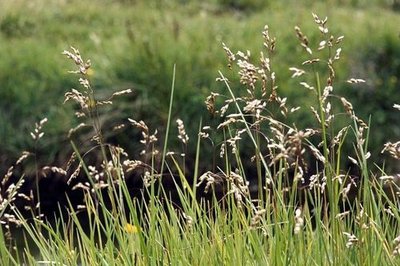
Hierochloe odorata - Bernard Nicollet - PNE  Flora
FloraHierochloe odorata
Also known as bison grass or sweet grass, this plant grows in wet grasslands and near fens. From its rootstock, it forms tufts between 60 and 70 cm high. Thanks to the coumarin inside it, it gives off a pleasant aroma, so that it is used to make distilled drinks. It is protected nationally and is also very rare in the Hautes-Alpes department.
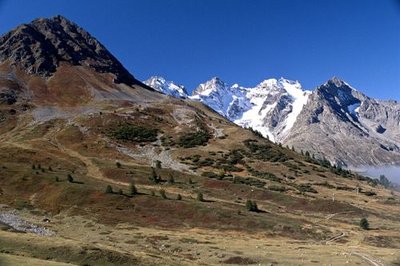
Avant le démantelement des téléskis - Eric Vannard - PNE  History
HistoryDismantled ski-lifts
A small ski resort was created in 1970 not far from the Lautaret mountain pass. Due to the risk of avalanches and new standards required, alpine skiing was moved near to the village of Villar d'Arène and Chazelet hamlet. The two obsolete ski-lifts situated in this very picturesque territory, rich in terms of biodiversity, ruin this place which has been classified since1974 as the national nature reserve of Combeynot. In 2013, dismantling was carried out by the Mixed union of ski-resorts in the Haute Romanche with the support of the National Park. In the end more than 35 tons of iron and concrete blocks were evacuated.
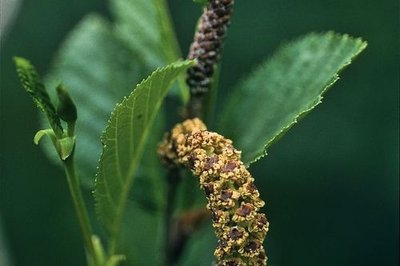
Chaton mâle et chaton femelle de l'aulne vert - Bernard Nicollet - PNE  Flora
FloraAlder forest and green alders
Here is a spectacular transition from the genuine forest and pastures of the north facing slopes. There is a thick grouping of shrubs made up essentially of willows and green alders. These will never reach the size of a tree. They constitute impenetrable thickets where, over time, boars, chamois and roe deer have outlined a maze to hide in. The plants provide nitrogen through their roots and fertilise the soil, as if getting their own back on the eutrophic tall herbs.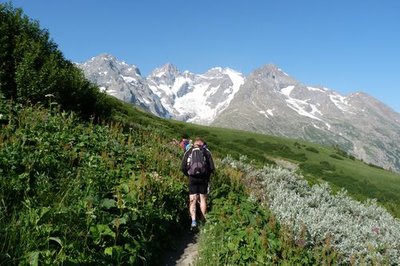
Le sentier traverse la megaphorbiaie. - Pierrick Navizet - Parc national des Ecrins  FloraTransition zone at the upper edge of the forest, it has large plants with big leaves that seek light in order to grow. Under cover of their leaves, some animals and plants find a safe haven, particularly alternate-leaved golden saxifrage and adenostyles alpina. On the east part of the Ecrins massif, eutrophic tall herbs can be found at the edge of streams and brooks. Just after snowmelt, it raises its golden head and constitutes a lovely carpet of flowers.
FloraTransition zone at the upper edge of the forest, it has large plants with big leaves that seek light in order to grow. Under cover of their leaves, some animals and plants find a safe haven, particularly alternate-leaved golden saxifrage and adenostyles alpina. On the east part of the Ecrins massif, eutrophic tall herbs can be found at the edge of streams and brooks. Just after snowmelt, it raises its golden head and constitutes a lovely carpet of flowers.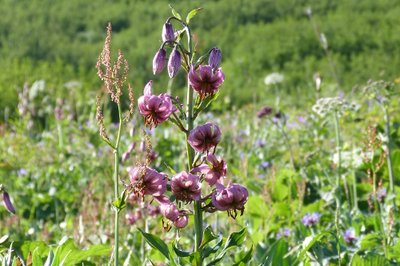
Le lys martagon - Pierrick Navizet - Parc national des Ecrins  Flora
FloraTurk's cap lily
The Turk's cap lily lodges on the grassy slopes, meadows and undergrowth. It can be seen from a distance due to it long upright flowering stalk from which stem three to ten majestic flowers. They are large, purple-pink with some crimson, and have six petals that turn upwards when they reach maturity. Six orange stamens are then visible. The flowers that bend downwards lift when the fruit is formed.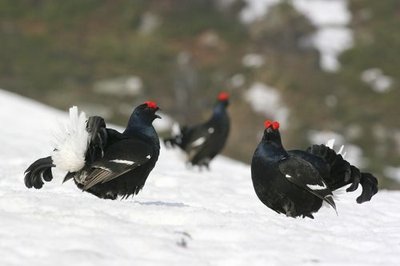
Parade de Tétrs Lyre au printemps - Robert Chevalier - Parc national des Ecrins  Fauna
FaunaBlack Grouse
The black grouse lives above 1200 m, and can only be found in the Alps. It is possible to spot the male due to its black plumage and its tail in the shape of a lyre (which is why its French name is Tétras Lyre). While it spends most of the time in winter in an igloo scooped out of the snow as protection against the cold, in the spring it performs spectacular parades to attract a female. The National park is tracking the population of the species in this zone.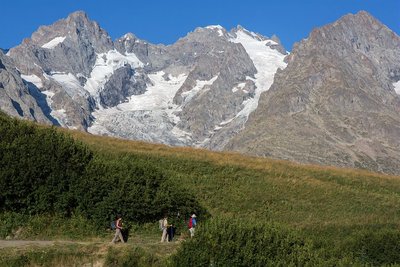
Vue sur la Meije depuis le sentier des Crevasses - © Parc national des Écrins - Pascal Saulay  Glacier
GlacierView over La Meije
La Meije is the second major peak in the Massif des Ecrins. It is made up of 3 main peaks: the Doigt de Dieu (3,973 m), La Meije Orientale (3,891m), and the highest summit, the Grand Pic at 3,983 m. It is a hard summit to climb, and the first to do so, on 16 August 1877, was Emmanuel Boileau de Castelnau, together with the famous local guide, Pierre Gaspard. "Meije" comes from the Occitan word Meidjo, which means midday, because when seen from the village of La Grave, the sun passes above the summit at around noon. On the other side, before La Meije became famous, it was called the Bec des Peignes (“Comb Beak”) by the inhabitants of Saint-Christophe-en-Oisans.
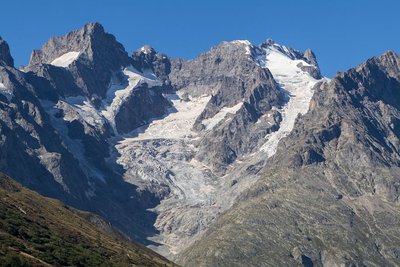
Vue sur le glacier du Lautaret et de l'Homme depuis le belvédère de l'homme - © Parc national des Écrins - Cyril Coursier  Panorama
PanoramaBelvedere de l'homme
A wooden guardrail is set up at the ideal spot for contemplating the descending glaciers of La Meije. The Lautaret glacier to the left and the Glacier de l’Homme to the right scarcely meet today. The last-named glacier is the descending ski slope from the Pic Oriental of La Meije and from the Aigle refuge (to be seen if you continue along the path towards the Rocher Blanc). The refuge is perched at an altitude of 3,450 m on a rocky spur. A new refuge was opened in 2014, preserving an existing wooden structure that dated from 1910.
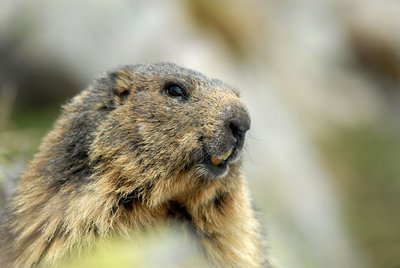
Marmotte au printemps - PNE - Papet Rodolphe  Fauna
FaunaThe marmots’ "bosse"
The alpine marmot is naturally present on grass at altitude. Here, it occupies a singular place which we call the marmots’ "bosse». This hibernating rodent is only visible between April and October. The marmot lives in a family and respects a hierarchy. Games, grooming, fighting and biting ensure the dominance of a couple as well as the cohesion of the group. Each animal participates in the delimitation of the territory by rubbing its cheeks on rocks and also by urinating and defecating there. When there is danger, the marmot emits a high and powerful whistle in order to warn the others.
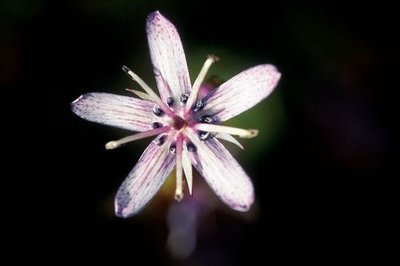
Swertie vivace - Bernard Nicollet - PNE  Flora
FloraFelwort
In early August, the felwort’s violet stars open in the sunshine. At the base of each of its five petals, two shiny pits full of nectar attract insects. A member of the gentian family, this beautiful flower is a perennial that survives the cold season with its persistent winter bud close to the ground, surrounded by a rosette of protecting leaves.
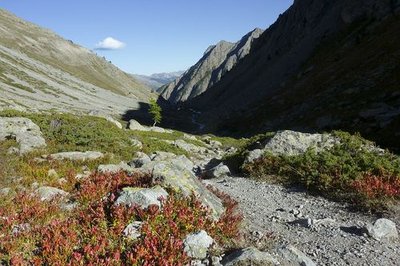
En descendant du col d'Arsine, sous les chalets du même nom. Vue plein est. - Cyril Coursier - PNE  Pass
PassArsine pass
The Arsine pass, is an important crossing point to visit on the GR54 Tour des Ecrins et de l'Oisans. It gives a remarkable viewpoint over the Angeaux massif. The pass is part of an old itinerary that was used instead of the crossing point by the Lautaret pass. It is also a crossing point between the Guisane and the Romanche area. This is an area that was mentioned as early as the Middle Ages as a place of conflict between the districts of Villar d'Arène and Monétier-les-Bains.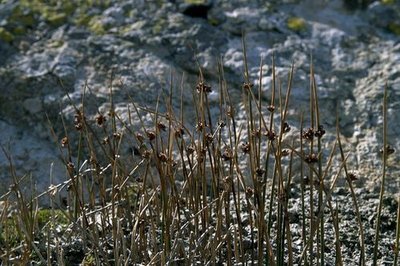
Jonc arctique - Bernard Nicollet - PNE  Flora
FloraArctic rush
Even though it is relatively common in some acidic marshland, the Arctic rush is nonetheless protected throughout the Rhône-Alpes and Provence-Alpes-Côte-d’Azur regions. It can be recognised because of its total absence of leaves and by the few blackish flowers in the upper third of the stalk. The flower tepals open at an obtuse angle and are a little shorter than the capsule.
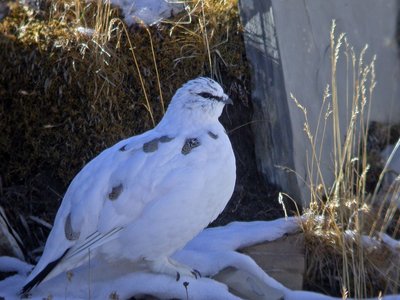
Le lagopède alpin en plumage d'hiver - PNE - Combrisson Damien  Fauna
FaunaRock ptarmigan
At five in the morning in the month of May, at an altitude of over 2,000 m, the sun rises over the fields of blueberry, which appear above the patches of snow. All of a sudden, a hoarse, almost metallic cry cuts through the peaceful dawn atmosphere: the rock ptarmigan is in the midst of its nuptial parade. Originating from the Arctic tundra, the rock ptarmigan, sometimes called the snow partridge, was to be found all over Europe during the ice ages, before its living space was limited to the mountains. Even today, it finds the conditions it needs to survive. The national Alpine parks have a great responsibility in conserving this species. The inventory carried out by the Haute-Romanche nature unit in 2005 showed there was a large core group of birds on the site.
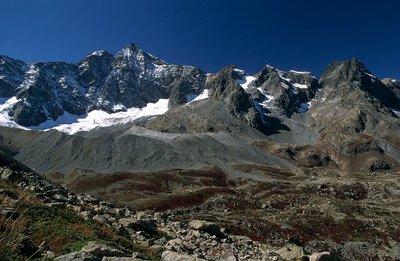
Anciennes moraines colonisées - PNE - Nicollet Bernard  Glacier
GlacierMoraines
The site of Arsine offers a complex moraine environment with a parade of ice margin flowers. The frontal moraine of the Arsine glacier is on a glacial vegetated rock complex that occupies about forty hectares at the bottom of the cirque. This complex is likely to have come about through a shifting of abandoned glacial deposits after permafrost was established. This means that the ground maintains a temperature of 0°C or less over several years. This phenomenon is likely to have taken place during the recent Dryas climatic cooling, that is to say 11 000 – 10 000 years BC.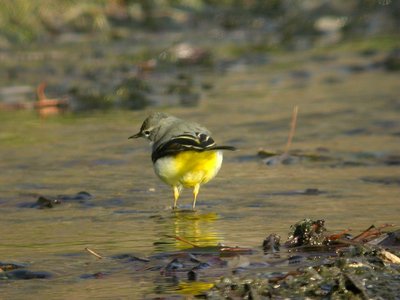
Bergeronnette des ruisseaux - PNE - Combrisson Damien  Fauna
FaunaAquatic diet
The grey wagtail is "hyperactive" and has a diet of flies, mosquitoes, dragonflies and all sorts of aquatic insect larvae. It hunts at the edge of the water, by jumping from stone to stone or hovers to catch its prey. It sometimes fishes for shellfish, molluscs, or even small fish to complete it meals. It does not leave the damp banks to build its nest either, and even looks for somewhere close to a waterfall or to flowing river.
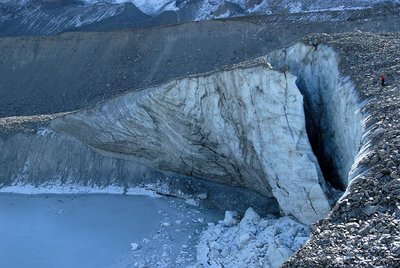
Détachement imminent d'un bloc du glacier - PNE - Masclaux Pierre  Glacier
GlacierIce calving
When the lake is frozen and the air temperature rises, the ice expands, provoking what is called the “song of the lake". The Lac Ouest is the last lake in the mountain range where it is still possible to see the fall of seracs (the front of the glacier) into the water, giving rise to this muffled noise.

 Glacier
GlacierThe melting Arsine glacier
Lake Arsine came to life in the 1950s after the Arsine glacier melted. Due to its rapid development, it was measured more accurately in 1969 and 1985, showing 800,000 m3 of water contained in a moraine that had been weakened by the ice inside it. Since it threatened to break, emergency work was undertaken the following spring to stop the rise in the level of the lake using a regulation channel dug across the frontal moraine. Almost 30 years later, the glacier site is still carefully monitored by Park employees. And the risk is now completely ruled out.
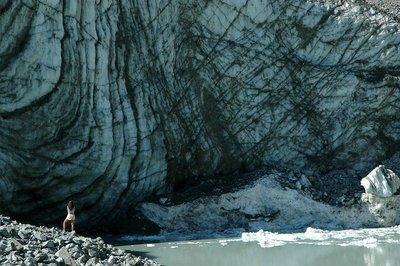
Le lac et le glacier d'Arsine - PNE - Masclaux Pierre  Lake
LakeArsine Glacier
The Arsine glacier is contained in the hollow of a vast corrie facing north, encircled by high walls reaching an altitude of between 3,200 and 3,600 metres. This is a glacier that is mostly hidden, with the front, currently at an altitude of about 2,470 m, behind lakes. The lakes are held back by an impressive series of old moraines, formed during the Little Ice Age (between about 1550 and 1850). Due to its size and preserved state, the old moraines of Arsine are an exception in the western Alps. Usually such morainic fronts are found in small, high-altitude glaciers, resulting water running too weakly to sweep away the accumulation of pre-glacier deposits (for example, the Réou d’Arsine glacier). The melting and shrinking of the Arsine glacier posed problems in the 1980s concerning water retention and therefore safety. RTM teams carried out work to lower the level of the lakes, the size of which raised fears of a break in the moraine with the risk of flooding the village of Le Casset.
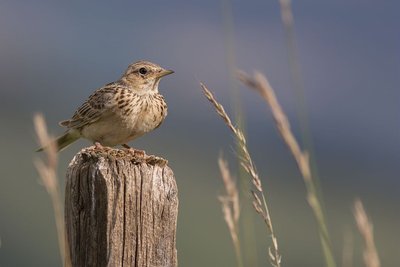
L’alouette des champs - PNE - Saulay Pascal  Fauna
FaunaSkylark
This bird is like a tightrope walker suspended in the sky, sounding out a long chorus of notes. Then, triangular wings back, and in a perfect spiral, the bird lands in the middle of the prairie. On the ground, it is difficult to see: its varying shades of brown means it is very well camouflaged. In its search for food, its movements, which are a succession of small sprints and sudden halts, enable it to spot possible predators.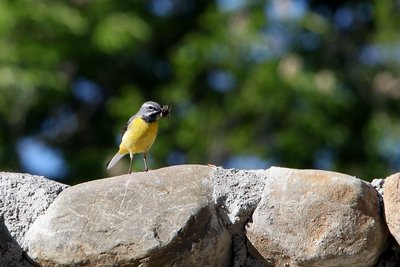
La bergeronnette des ruisseaux - PNE - Saulay Pascal  Fauna
FaunaGrey wagtail
The grey wagtail elegantly hops along the rocks at the riverside. They are found in mountain streams, but also near all waterways in the mountains, in the countryside or in towns, and even small high-altitude lakes. Like other wagtails, they continually wag their long black tails edged with white. They have yellow breasts like the western yellow wagtail, but their backs are ash grey. In the mating season, males proudly show off their black throats, making it easier to tell them apart from females, whose throats and breasts are partly white. Their pinkish claws are specific to the breed, since other wagtails’ claws are black.
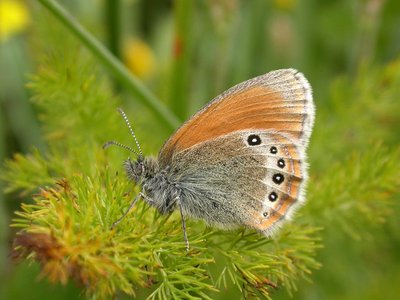
Satyrion (papillon de jour) - PNE - Delenatte Blandine  Fauna
FaunaButterflies and moths
Butterflies can be distinguished from moths by the shape of their antennae. You will also notice that when resting, the butterflies wings are vertically folded over the body for necessary discretion while the moth's cover them. The moorland clouded yellow butterfly has another unusual habit: as soon as it becomes too cold to fly, it settles and bends its side to the sun to absorb energy. It can even lean slightly, whereas others tend to fully, and dangerously spread themselves out.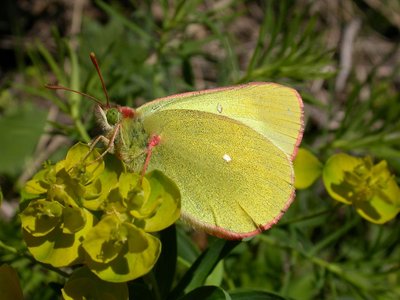
Solitaire mâle sur une euphorbe - PNE - Delenatte Blandine  Fauna
FaunaMoorland clouded yellow
The heath surrounded by heather and willows is the home of a population of unusual and protected butterflies: the moorland cloud yellow. Elsewhere, it lives in different environments, such as blueberry heaths and peatland, where the moorland clouded yellow is rare and hard to spot. It can be recognised by its yellow display delicately sprinkled with grey under the rear wings of the male, while the female of the species has adopted almost purely white wings. They both wear a simple pink border highlighting the edge of their wings, with a tiny white ocellus (eye) encircled with brown and a discrete grey crescent.
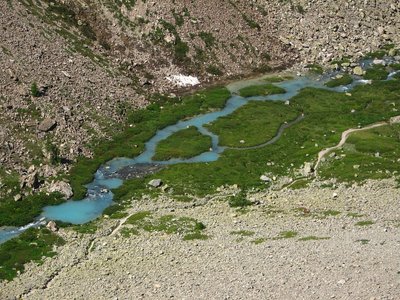
Eaux turquoises du Petit Tabuc - PNE - Coursier Cyril  Water
WaterWater colour in the meanders
The turquoise colour of the water that meanders from the Petit Tabuc stream gives a special character to this remarkable site. The valley is popular among photographers and artists for its photographic and pictorial quality.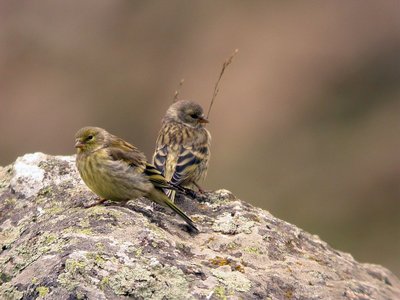
Deux venturons montagnards - PNE - Combrisson Damien  Fauna
FaunaAlpine citril finch
A small green-yellow-grey bird sways on a tall branch. Chet! The Alpine citril finch flies off to land on a scrap of threadbare grass. It looks like a small greenfinch, but the strident cry it makes during its short flight clearly sets it apart. Its head and breast flanks are a pretty blue-grey colour. Its yellow wing stripes can be easily seen. When flying over longer distances, its undulating flight is reminiscent of a goldfinch’s. And just like its cousin, the finch is sociable and moves about in small groups when exploring some sparse group of nettles or grass.
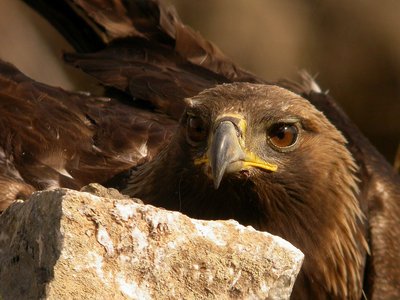
Aigle royal - PNE - Combrisson Damien  Fauna
FaunaGolden eagle, the Ecrins' mascot
The Petit Tabuc site is ideal for the golden eagle to nest. The golden eagle is amongst the protected species that are considered rare in Europe. The size of the populations that have been registered in the Ecrins massif, bestow a strong responsibility on the Park for conservation of the species. Counting takes place regularly since 1985 along with monitoring of reproduction, causes of disturbance and mortality.
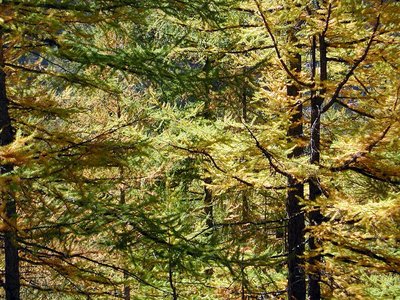
Mélezin - PNE - Quellier Hélène  Flora
FloraLarch
The larch is the only European resinous tree to lose its needles in winter. Its wood is red-brown. It stands out in the landscape with its leaves ranging from a soft green colour in spring to gold in autumn. Its pink flowers attract naturalists and photographers in the spring. The larch tree is a coloniser of mountain slopes. Although it is at home in the harsh conditions of the mountainside, it cannot bear competition from other trees. The Petit Tabuc site is a fine example of its colonising capacity, even though it is regularly hit by avalanches.
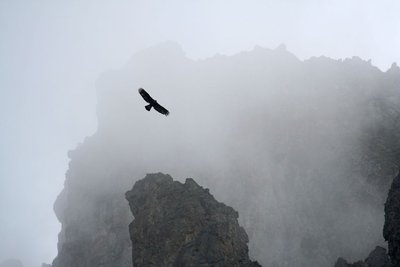
Aigle royal dans la brume - PNE - Telmon Jean-Philippe  Fauna
FaunaA flying predator
The eagle is the archetypal predator. Everything about it suggests strength and daring. Its appearance, of course, with its impressive expression highlighted by the prominent brow ridge, but above all its fearsome weapons: rapid flight, which can be adapted to even the most acrobatic situations, and sharp, powerful talons. Its keen eyesight helps it detect its prey, from the marmot to the young chamois, ptarmigans and hares. In winter, it often takes its food from the dead bodies of animals, helping towards the natural cleansing of nature.
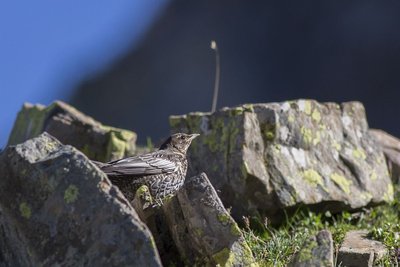
Jeune merle à plastron - PNE - Saulay Pascal  Fauna
FaunaRing ouzel
In the pastures covered with larch or 'bush", a cry of alarm followed the start of a song resounds. A blackbird? Yes, but more specifically a ring ouzel. This shy, swift mountain blackbird lives on the fringe of the larch, scots pine, spruce or Swiss pine forests between 1000 and 2500 m in altitude. The ring ouzel is a migratory bird that spends winter in Spain or North Africa before coming back to the mountains around March.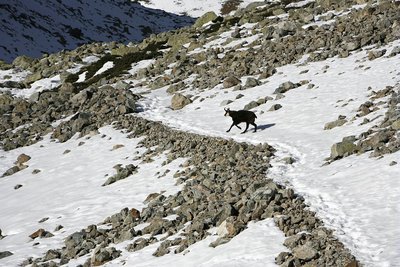
Chamois mâle au moment du rut dans le vallon du petit Tabuc, à proximité du Mônetier-les-bains - Cyril Coursier - PNE  Fauna
FaunaChamois
Rupicapra rupicapra, the mountain goat was not at first solely a creature of the mountains. The species is more attached to rocky escarpments and steep slopes than high altitude. But strong human pressure on chamois made them withdraw ever higher. Coveted as a hunting target, they have found refuge here in the Ecrins National Park.
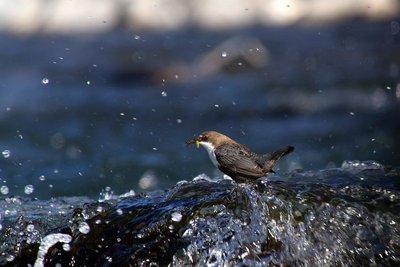
Cincle plongueur avec son repas dans le bec - Damien Combrisson - PNE  Fauna
FaunaWhite-throated dipper
The mountain streams relinquish their secrets to an attentive hiker. The master of this little world is a small brown, red and grey bird with a short tail and a pure white breast, separated from the darker abdomen by a light brown stripe. We can often see it in the air, flying close to the water to snap up insects. The dipper owes its name to its eating habits to find water larva, it dips its head into the water and grips the riverbed to walk against the current.
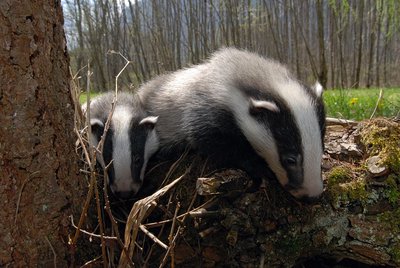
Deux jeunes blaireaux - PNE - Fiat Denis  Fauna
FaunaEuropean badger
You will often see a badger at nighttime on the edge of a path, a road or an embankment. The gentle pace and portly gait of this member of the mustelid family are reminiscent of a small bear you may get a glimpse of his black and the white stripes on his head before he hurries away. Worms, reptiles, frogs, fruit and plants are his staple diet. Families of badgers live in sometimes very extensive and very old burrows, with numerous chambers and galleries. They are tolerant animals, since they will sometimes share their home with rabbits and foxes. Badgers are among the unobtrusive neighbours whose presence goes undetected, except for their footprints made up of five nearly parallel toes and the tracks of their long claws.

 Vernacular heritage
Vernacular heritageMadeleine Hospice
At an altitude of 1,810 m, below the present-day Col du Lautaret road, the Madeleine hospice helped travellers cross the pass in all weathers and provided pilgrims with a chance to rest on their way to Rome or the Holy Land. The foundation of the order of the Holy Penance in these buildings dates from 1228. There is a chapel on the site, and it is located on a former road from Briançon to Grenoble. An avalanche destroyed the Madeleine hospice in 1740, and the building was rebuilt, then abandoned, when the road to Lautaret was modernised.

 Panorama
PanoramaView over the Pic de Rochebrune
The Guisane valley descends towards Briançon to the south-east. The view opens up in the distance towards the Massif du Queyras, with one of the summits clearly visible. The Pic de Rochebrune, at an altitude of 3,320 m, stands proudly above the Cervières valley, 10 km from Briançon and from the Guil valley in the Queyras region, linked by the Col de l'Izoard (2,361m). This enormous dolomite rock bastion is accessible to experienced hikers, since the last part is somewhat steep and you need to use your hands to climb up in places.

 History
HistoryLe Massif de Combeynot, W. Brockedon
In the work by W. Brockedon, Illustrations of the Passes of the Alps, published in 1828, one of the engravings illustrating the Col du Mont-Genèvre shows, according to the title: Mont d'Arcines and the Val de Guisane from the Col du Lautaret (p. 25). The view is described as follows: "Across a deep ravine, the River Guisane is seen tumbling down the mountains from its source in the distant glacier of Mont d'Arcines, and thence flowing on to the Durance, through the narrow valley which is bounded by rugged and pinnacled mountains ". On the previous page, it says that "Le Casset is near the foot of the Glacier de Lasciale, which descends from the Mont d'Arcines". So it is clear that Mont d'Arcines is the present-day Les Agneaux mountain, and the Lasciale glacier is the Casset glacier, which must have reached much lower down. However, Paul Guillemin thinks that this is the first printed depiction of La Meije, and he marks it as n° 2 in his inventory (PG: 2). This was an error of interpretation on his part. In fact, it is the view over the Massif du Combeynot from the old Lautaret road. From this viewpoint, Les Agneaux (or Mont d’Arcines) cannot be seen.

Le col du Lautaret vu depuis Laurichard - © Parc national des Ecrins - Cyril Couriser  Pass
PassThe Col du Lautaret climate
The Col du Lautaret is a climatic limit between the northern and southern Alps. It works like a barrier for rough weather, and it is not unusual that the Romanche valley to the west is filled with snow, while the Guisane valley to the east is dry, and vice versa. The Romanche valley runs down directly to the region of Grenoble, where the climate at the same altitude has twice as much precipitation, and so works as a corridor for rough weather coming from the area. This explains why the Col du Lautaret and the neighbouring Col du Galibier mark the limit for many plants with Mediterranean affinities. This transitional position is characterised by a climate with a strong Mediterranean influence in the direction of Briançon.

 Geology and geography
Geology and geographyThe tuffaceous ground of the Col du Lautaret
Tufa is a sedimentary rock produced by the precipitation of limestone dissolved in water, which comes to the surface from a water course or spring. In the course of this mineral solidification of carbonates, a great deal of plant or animal debris is trapped and becomes fossilised. This is how an excavation operation carried out between 2008 and 2010 was able to reconstruct the flora on the pass when the rock was deposited long ago. Tufa is also a soft rock which can be sculpted easily and was highly valued for the construction of public buildings or the houses of local dignitaries. The church of Villar d'Arène is built from tufa from the Le Lautaret quarry, a resource it almost exhausted. The tufa zone of Le Lautaret is listed as a habitat of community interest within the Natura 2000 site «Combeynot Lautaret Ecrins».
Forecast
Altimetric profile
Sensitive areas
Peregrine falcon
- Impacted practices:
- Aerial, Vertical
- Sensitivity periods:
- FebMarAprMayJun
- Contact:
- Parc National des Écrins
Julien Charron
julien.charron@ecrins-parcnational.fr
Alpine ibex
- Impacted practices:
- Aerial, , Land, Vertical
- Sensitivity periods:
- JunJulAugSep
- Contact:
- Parc National des Écrins
Julien Charron
julien.charron@ecrins-parcnational.fr
Golden eagle
- Impacted practices:
- Aerial, , Vertical
- Sensitivity periods:
- JanFebMarAprMayJunJulAug
- Contact:
- Parc National des Écrins
Julien Charron
julien.charron@ecrins-parcnational.fr
Golden eagle
- Impacted practices:
- Aerial, , Vertical
- Sensitivity periods:
- JanFebMarAprMayJunJulAug
- Contact:
- Parc National des Écrins
Julien Charron
julien.charron@ecrins-parcnational.fr
Recommandations
 In mountain pastures, protection dogs are there to protect the herds from predators (wolves, etc.).
In mountain pastures, protection dogs are there to protect the herds from predators (wolves, etc.).
When I hike I adapt my behavior by going around the herd and pausing for the dog to identify me.
Find out more about the actions to adopt with the article "Protection dogs: a context and actions to adopt".
Tell us about your meeting by answering this survey.
Information desks
Information center "le Casset" (summer only)
Le Casset, 05220 Le Monêtier-les-bains
At the entrance of the hamlet of "le Casset" and near the core zone of the Park, a stop before or after your walk... Projections, documentation, books of the Park. Free admission. All animations of the Park are free unless otherwise stated.
Information center "Col du Lautaret" (summer only)
Col du Lautaret, 05220 Le Monêtier-les-bains
Under the gaze of the Meije (3983 m) and surrounded by beautiful meadows celebrated in the great names of botany, the former hospice of the Lautaret called "refuge Napoleon" houses the reception and information Park center - Projections, documentation, books of the Park. Accessible to people with reduced mobility. Free admission.
Maison du Parc du Briançonnais
Place Médecin-Général Blanchard, 05100 Briançon
Located at the foot of the medieval town fortified by Vauban, declared World Heritage by UNESCO in 2008, the Maison du Parc Briançon is a welcoming place of information exchange. Three floors of exhibition to discover : the natural and cultural heritage, the museum of the history of skiing in Briançon. Documentation, maps, guidebooks, books and products of the Park. Guided tours for groups by reservation. Free admission.
Transport
Auvergne-Rhône-Alpes bus lines : https://carsisere.auvergnerhonealpes.fr/
Isère bus lines : https://www.itinisere.fr/
Access and parking
From Briançon, take the D1091 following signs towards Grenoble. Pass through Monêtier-les-Bains and continue straight on until you reach the Col du Lautaret.
From Grenoble, take the D1091 following signs for Bourg d'Oisans; then carry on towards La Grave and climb up to the Col du Lautaret. Note that if the Chambon tunnel is closed, you will have to take the relief road.
Parking :
More information
Source

Report a problem or an error
If you have found an error on this page or if you have noticed any problems during your hike, please report them to us here:


